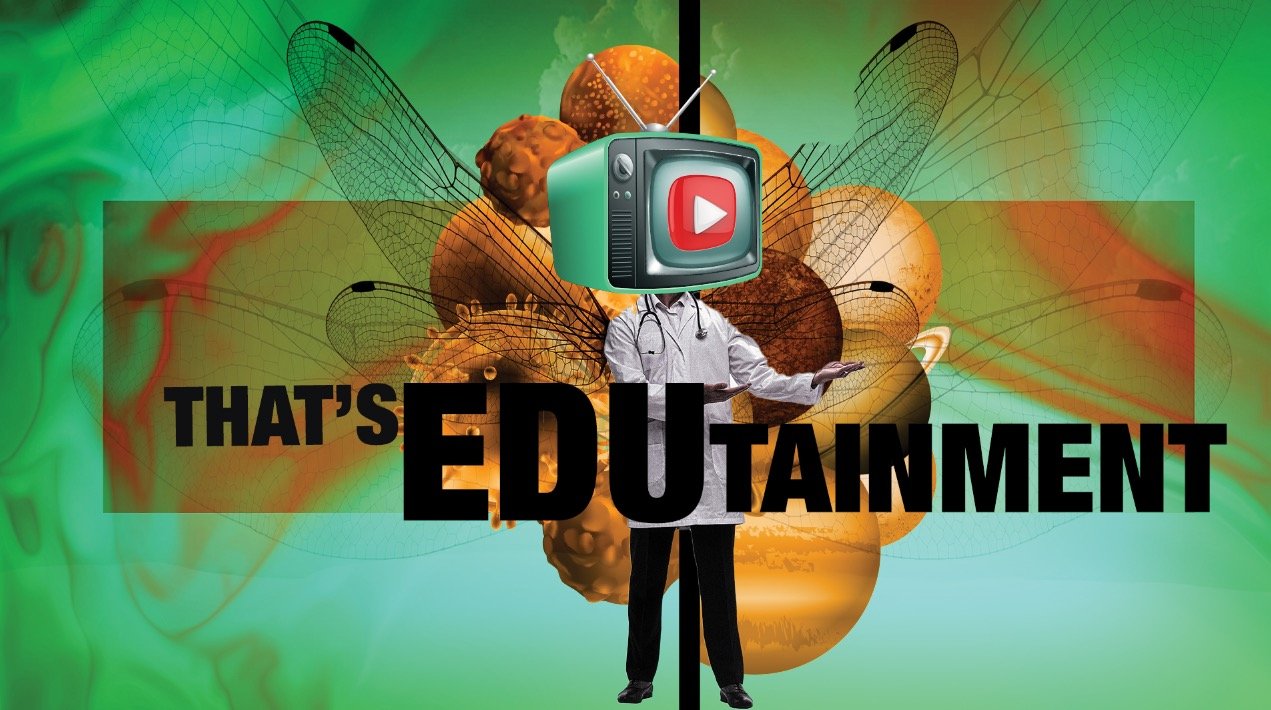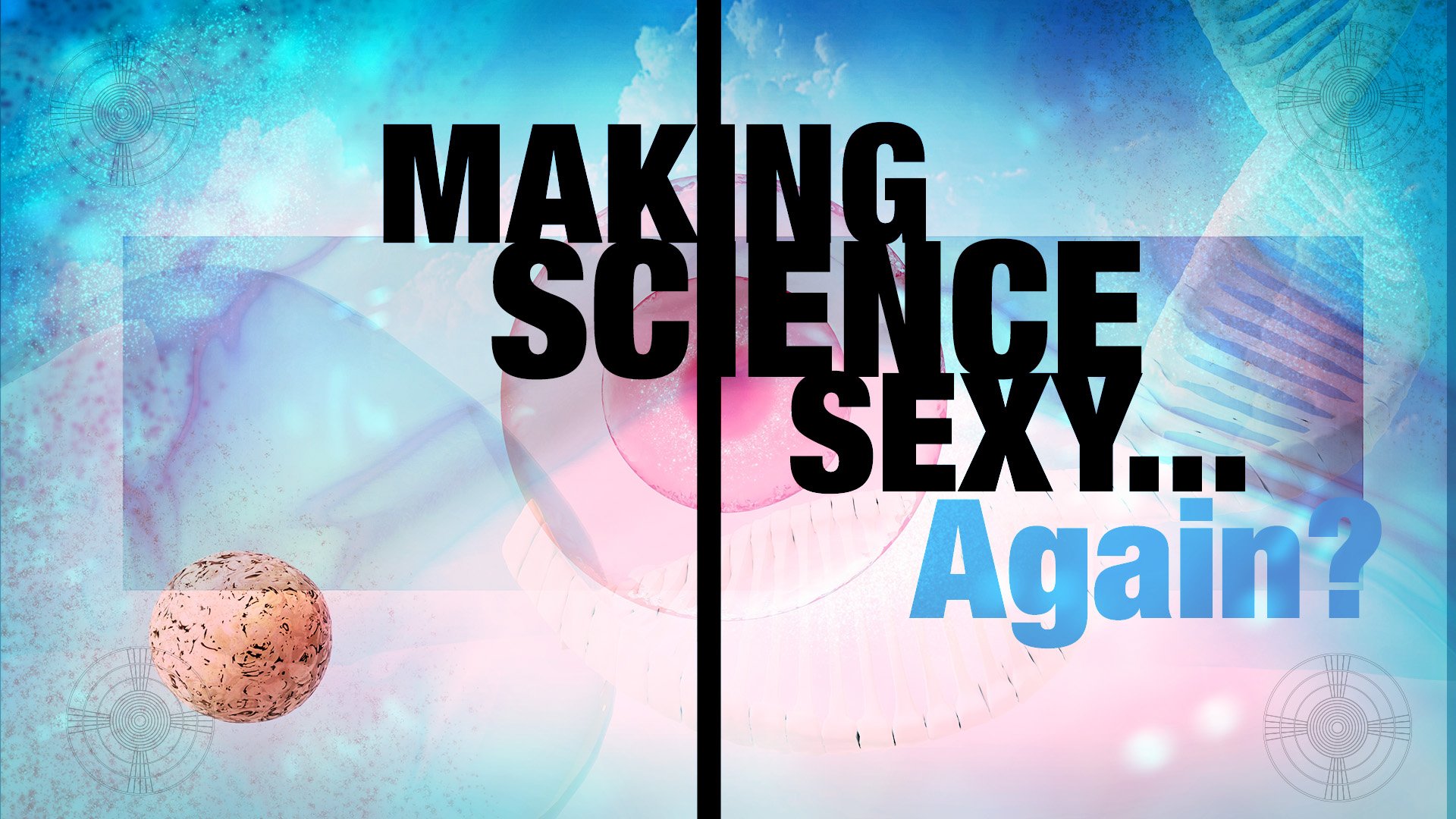That’s Edutainment!
If you would like to see video or healthcare/pharma work ACOMPANY.NYC has created, please contact us.
Art by Sean Mosher-Smith and Anna Varshavsky.
Words by Anna Varshavsky
Edutainment noun /ˌedjʊˈteɪnmənt/ the process of entertaining at the same time as teaching.
Under the Microscope
I flunked science. My yet-undiagnosed dyslexia and ADHD kept my mind wandering around the classroom, lulled by the drone of my teacher’s voice, speaking words I recognized but strung together in a nonsensical word salad my brain couldn’t compute or focus on. Sometimes I read Ray Bradbury under my desk. Science fiction seemed within the context of whatever was being taught in class.
My aversion to science wasn’t for the lack of curiosity. In junior high, I was obsessed with a microscope that was donated to me by kind American neighbors when we first moved to the USA. It was literally the only toy I had.
The microscope was an old and tired thing with broken knobs and peeling paint, wobbling on my desk, threatening to fall to its inevitable demise. It came with a wooden box of slides, the glass cracked and chipped along the edges, yet the interiors in were in decent condition, perhaps because the box was small and the slides were crammed in like sardines. I sliced my fingertips every time I went to fish one out.
Squished in the glass were flies and other insects, flower petals, and some sort of liquids. I would magnify a fly’s head and stare at it for hours, moving the slide around to see the intricacies of its wings. I’d doodle what I saw: complex and abstract patterns.
There were only about 10 slides, and after a month I began using myself as a subject for magnification, placing a hair, a nail clipping, and even a drop of blood from my cut finger under the microscope. It didn’t produce the Jules Verne Fantastic Voyage magnification I was hoping for. But I persevered, magnifying plants, cloth, and ultimately graduated to used bandaids.
It wasn’t the best of microscopes to say the least, but it kept me intrigued and got me curious about shows like NOVA. I realized that there’s a microcosm inside each object—a universe of cells and other living organisms that form galaxies. My exploration made me comprehend the sheer complexity of our bodies and that they’re a housing unit for organisms and cells that have a life and purpose of their own. And it is those mechanics that make us function and stay alive. This was science, not fiction. It took play and entertainment for me to appreciate science and learn, instead of being lectured and talked at.
Child’s Play
At Scholastic, managing the Literacy Place project, a behemoth undertaking for grades K-12, I came across another type of science: pedagogy. It was fascinating to learn how knowledge and skills are imparted in an educational context and the interactions that take place during learning. Although the methodology is not consistent from state to state and from mindset to mindset, the key takeaway for me was that edutainment featured prominently, and with great success, as a learning tool for younger children.
Edutainment is/was nothing new. A hybrid of education and entertainment, it is a part of television heritage: Sesame Street, The Electric Company, Blue’s Clues. Incidentally, I learned English by watching Julia Child’s The French Chef, and in the process also learned how to cook!
And, while helping create videos, books, and games at Scholastic, I always wondered, “Why aren’t these tactics applied to the older grades' curricula or for teaching adults?” I parlayed that question into practice when I began working in healthcare advertising, at times creating communications for people who excelled at the science classes I flunked.
Making Science Sexy…Again?
It was in pharma that my microscope explorations evolved into a full-on laboratory, full of cells, antibodies, T-cells and B-cells, neurons, and the beautifully graphic gene coding. I was obsessed with the abstract shapes of these micro-entities and the surrealistic ecosystem they inhabited inside my body—everyone’s bodies.
For years, I tried to make science sexy through MOA (mechanism of action) videos amplifying the biology and hoping that the viewer would see its artistic beauty. But the result of those videos was the same as my teacher’s monotonous voice, causing little retention of information and a high drop-off rate. Plus, there are a few mandatories in pharma that are visual obstacles for creativity: the video has to be bookended by fair balance (indication and disclaimers) unless it’s an unbranded disease initiative—and even then, the regulatory mandates handicap the overall impact.
But every obstacle is an opportunity. For me, this meant that the deliverable had to work harder at enticing the viewer to withstand the legalese in order to get to the meat of the information. For patients, a video that is entertaining can do the heavy lifting of either educating them directly or in tandem with HCPs about their disease and its management and treatment adherence. Furthermore, about half of Americans read at a sixth grade level. Edutainment is the perfect vehicle to overcome that barrier.
As for HCPs, a close friend and prominent physician from Oregon has always told me, “Anna, doctors are people too. We watch Netflix, we know who the Kardashians are, and I have Star Wars on a loop because my kid is obsessed with it.” The edutainment tactics for HCPs have to be science-forward—a quick and seamless information resource—but also take the HCP specialty and role into consideration to make it relevant and relatable with an appropriate tonality. All this doesn’t mean that the end product is dull—quite the contrary: busy HCPs don’t have time for advertising. They’re too busy saving lives and trying to live theirs. Whatever is created has to have value and make that 2 minutes and 30 seconds count.
Weird Science
What I was initially producing was de rigueur in the industry—I was creating what was expected, which didn’t reflect what I saw. However, an exercise from a workshop at The One Club sparked a pivotal epiphany. In the workshop, we were challenged to create concepts outside the parameters of reality, be it underwater, in space, on a different planet, in a different dimension—anything but what was expected. It made us, at ACOMPANY.NYC, focus on our vision of the cellular space, because we see cancer as a disgusting villain, something that can only be equated to the Alien or the monster in the Upside Down from Stranger Things. For us, viruses took the shape of sentinels from Matrix and antibodies became the resistance’s ships in Star Wars (seriously, look at them from an aerial view!). So, we decided to let our sci-fi freak flag fly. What’s the worst that can happen?
Rejection. There weren’t a lot of clients who would buy into those ideas, much less invest their budgets into something that didn’t seem credible—and credible meant literal, colloquial cells and organs inside CGI bodies that made cadavers and zombies look lifelike and not in a gamer-Resident-Evil kind of way.
So, we persevered. We offered storyboards featuring pretty cells and happy people intermixed with our weird sci-fi ideas. And, finally we found a client who appreciated our weirdness.
It is with this client that we created a large array of MOA and educational videos (some of them are up for awards this year). The work ranged from Pixaresque characters to sophisticated, Renaissance-style painterly anatomy animated within abstract shapes. These concepts are vehicles to tell a complex high-science story, which is painstakingly boiled down to its 2-minutes-and-30-seconds essence.
This is achieved only after trying not to fall asleep reading 400 pages of dense PPT slides. (Perhaps that’s my karma for not listening to my science teacher.) We managed to test the patience of medical and science advisors—we would always preface with the request that they speak to us as if they were speaking to 5-year-olds. The main takeaway is that the video had to tell the synopsis of the story, enticing the viewer to read and learn more—to become curious and pick up a figurative microscope of their own. Continue the research.
Give Them the Finger
The most rewarding experience in creating such videos is working with the right animation partner. In Finger Industries, my team and I found an invaluable visionary who was excited about science and actually “got” our bizarre visual references. Their contribution to the overall vision added an extra layer to the stories. And, we’re always enchanted to see how one of our awkward doodles evolves in their masterful hands. It becomes not a job but truly play time. Every meeting is like opening a birthday present—the awe and surprise of seeing an idea materialize as a fleshed-out character in an unearthly environment.
The Hard SeLL
The videos we, at ACOMPANY.NYC, create take the MOA story outside the parameters of literal biology. This translates not only into clicks but, most importantly, information retention and engagement. The story that uses a visual metaphor to convey the main idea can be comprehended quickly by anyone, whether it’s an HCP or a consumer/patient/caregiver. It makes people smile, sometimes laugh, or look at something beautiful whilst learning. And that’s enticement to actually watch the full video, to be entertained while eating a sandwich at a desk or trying to find out more about a treatment, disease, or medical care. But most importantly, these videos will appeal to a large demographic of American patients who need information but struggle with reading. Edutainment will feel less like school and being talked at, and feel more like living a life.
Ultimately, we work in advertising so the goal of the communication we create is to promote a product or brand. The device we use to gauge all creative is: “SeLL:” Stop, Listen, and Learn. In other words, the deliverable must not only have stopping power, but also have the message listened to in its entirety, so when the viewer walks away they would have learned something. Edutainment does all that and more.
Effectiveness of edutainment video on HCPs:
https://aricjournal.biomedcentral.com/articles/10.1186/s13756-019-0531-5
Video learning may lead to more information retention and better learning:
Literacy levels in American adults:







